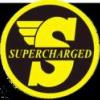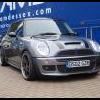Hey all again,
I've been running my charged clubman now for about 18 months but only clocked up about 500 trouble free miles, anyway i decided after a lot of ummming and arrrring to whip the charger off and make a new inlet manifold (charger to head inlet) as i wasn't really happy with the one supplied, i'm convinced it could be a lot more efficient....so the charger came off and as soon as i had a look at the lobes/rotors i noticed the Teflon coating was coming off to reveal shiny machined lobes/rotors, i wasn't happy with what i saw as i imediately started thing about engine/piston bore wear, i'm not sure how flakes of Teflon are handled in this scenario, I also started to think about the compresion capability of the charger, i understand that the Teflon is applied in an extremly thin layer (microns thin) but as opposing lobe/rotor surfaces lose the thickness of the Teflon then i assume the efficiency will also drop....you may think i'm being mad but they spin upto 14000rpm and are close tolerance parts.
So i'm asking whether anyone else has experienced this and if so what do you suggest?
Next issue, the Manifold, has anybody else got the Jonspeed manifold, it is very simple, it has a poorly positioned inlet/feed hole into a U shaped inlet branch which feeds the chambers, (the hole on the mounting face of the charger is awfully positioned as is the diameter which is exactly the same of just 1 of the manifold branches) am i correct in suggesting that charged fuel/air being forced through an opening of lets say 1"1/4" and is then shared imediatly between 2 exactly the same exits is maybe not the best way to work?! I guess now unless you have thought this yourself then it may sound a bit stupid. What i am going to do is dedicate that particular feed for just 1 pair of chambers and fabricate another same length and diameter feed for the other pair of chamber.....no cross feed just 2 equal length and diameter inlet branches.
How does this sound?
Kind regards
the turd

Eaton Teflon Coating Issues
Started by
79flyingturd
, Mar 22 2010 07:42 PM
3 replies to this topic
#1

Posted 22 March 2010 - 07:42 PM
#2

Posted 22 March 2010 - 09:16 PM
The attached picture was the result of 200 miles and on a brand new engine. The good news is the engine kept its compression because I measured it afterwards. This was using the Jonspeed inlets.
The only way to stop this is to feed the fuel after the supercharger. I toyed with the idea of two injectors on the manifold but my opinion is that these superchargers really are not worth the hassle, the idea is better than the reality. So I decided to rebuild to a 7 port normally aspirated to get similar power but in a much nicer to drive/maintain setup.
I expect you could get a specialist company to put a tougher coating on the rotors, but im expecting its going to make the rotors heavier and a little slower maybe. Not to mention costing an absolute fortune!
The only way to stop this is to feed the fuel after the supercharger. I toyed with the idea of two injectors on the manifold but my opinion is that these superchargers really are not worth the hassle, the idea is better than the reality. So I decided to rebuild to a 7 port normally aspirated to get similar power but in a much nicer to drive/maintain setup.
I expect you could get a specialist company to put a tougher coating on the rotors, but im expecting its going to make the rotors heavier and a little slower maybe. Not to mention costing an absolute fortune!
Attached Files
#3

Posted 22 March 2010 - 10:13 PM
This is interesting. I have done about 6K on my Sc12 with no changes to the rotors. I wonder why the M45's are suffering?
#4

Posted 23 March 2010 - 12:50 AM
There are 2 types of rotors for the M45 supercharger, grey coated rotors and black coated rotors. The black coated rotors where used on the JCW conversions and were suppose to take the extra heat from the extra boost used.
Graham
Graham
1 user(s) are reading this topic
0 members, 1 guests, 0 anonymous users















